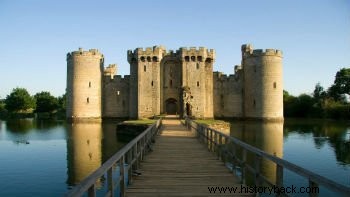The medieval castles begin to be erected when Western Europe was invaded by the Nordic peoples.
Faced with the danger, there was a need to increase the defense of the territory by building more solid structures to resist the attacks of the so-called "barbarian peoples".
Origin

Bodiam Castle, England.
Castles began to be built around the year 800 on ruins of Roman buildings and fortifications. These early castles were wooden structures protected by palisades and later, walls of stone and rock.
They were always on the highest part of the ground, preferably on top of a hill, in order to facilitate surveillance. They could also be by the river that formed a natural defense.
With the increase of the Nordic invasions and the end of the Roman Empire, the wood was being replaced by stone and, even the civil constructions, such as monasteries and churches, followed the defensive style.
The walls grew in size and became huge walls where knights and soldiers could circulate in case of attack.
It is important to note that the castles not only served for defense, but also increased the feudal lord's authority over his manor.
After all, they allowed the surrounding area to be controlled and an administration center formed, providing the lord with a place to hold the court.
Thus, the castles came to symbolize the power of the noble and the family that inhabited them. Therefore, home improvements such as chimneys, kitchens, furniture, paintings and large rugs were introduced to minimize the winter cold.
Read more about Feudalism.
Characteristics
A medieval castle has easily recognizable features such as high walls, towers, small windows, gunboats, etc. In the dungeon, there were cells that housed prisoners of war.
The most sensitive point of this type of construction was the main entrance. For this, architects invented all kinds of protection.
From digging a ditch and filling it with water and waste, building a double door to using bridges. Equally, iron gates that could be opened and lowered vertically through mechanisms driven by pulleys.
Construction
Castles took years to build and employed a large number of workers to build them. Cleavers, stonemasons, artisans, carpenters and joiners were dedicated to shaping stones, building towers and opening windows.
Prisoners of war were often employed to carry out certain tasks such as repairing damaged parts. Animal power, water-powered mills or human traction were used to transport the material and lift it to great heights.
The raw material used was mainly stone and this could be a problem when there was a shortage of material. Certain walls were built with stones taken from ancient Roman cemeteries, for example.
Other castles were built with stones brought from farther away, extending the construction time.
Likewise, wood was used for finishing and support. Entire forests were devastated to build castles and also the houses of the serfs who would live around the feudal lord.
Learn more about Medieval Architecture.
Castle, watchtower, fortress, citadel or palace?

Citadel of Carcassone, France, with double walls.
Although the word "castle" is used generically, not every castle was a palace. Discover the main differences between these constructions:
Castle – construction capable of repelling invaders and protecting occupants for long periods of time. The feudal lord's family and his closest collaborators lived inside.
Watchtower - building generally composed of a single tower in order to monitor the surrounding land. Every castle had its watchtower, but not every watchtower was a castle.
Fortress – had an exclusively military function and no family lived in these places, only the soldiers. They begin to be built by the nobles when they could make an exclusive fortress for their armies. Also when National States are formed
Citadel – is the protected part of the medieval city where the inhabitants of the surroundings could take refuge in case of war.
Palace — where a member of royalty, usually the king, lived. It was actually built to show the pomp and wealth of the ruling family and had no defensive function.
Castle Decay
Castles ceased to be built in Europe around the 16th century. Several reasons explain the abandonment of this building:
- the widespread use of gunpowder that caused irreparable damage to the walls,
- population growth making the territory increasingly larger and impossible to fortify,
- the rural exodus that displaced the workforce to the cities,
- the consolidation of the National State that centralizes the power of arms in the hands of the king creating the first national armies.
The end of castles is part of the decadence of the Middle Ages. To learn more, read the text Low Middle Ages and understand the changes that took place in this period.
Curiosities
- The castle of Doué-la-Fontaine in France, built around 950, is considered the oldest in Europe.
- Malbork Castle is said to be the largest in Europe. Located in Poland, built in 1217, it has 210,000 m².
- Also the Moors built castles in Europe. One of the best examples of this type of construction – called the “alcázar” – is the Alhambra (the Red) located in the city of Granada, Spain.
